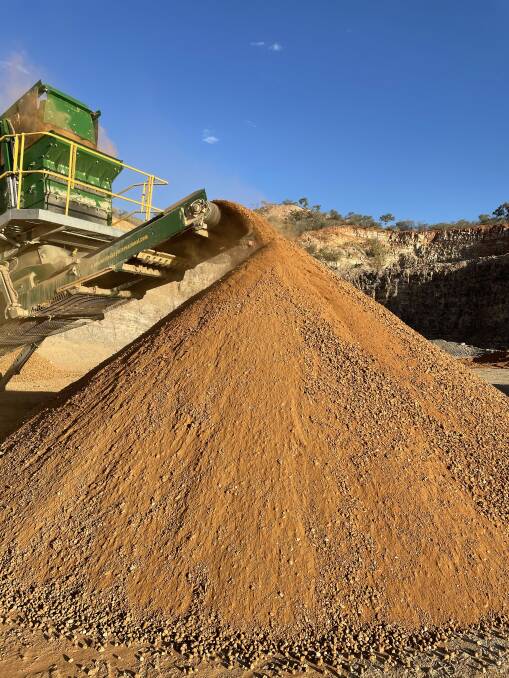
A NEW phosphate rock mine in north-west Queensland will provide a valuable new source of phosphorus-based fertilisers for Australian farmers.
Centrex Metals' Ardmore mine is south of Mt Isa and will be capable of producing 800,000 tonnes of phosphate rock each year, which will translate into around 600,000 tonnes of phosphate-based fertiliser.
The phosphate being extracted has a high percentage of P and is low in cadmium, which is an issue with some imported products.
At this stage, Centrex has said the mine will have a minimum 10-year life span.
Wes Lefroy, Rabobank agricultural analyst said Australian farmers use just short of 2 million tonnes of P-based fertilisers per annum, mostly in the form of MAP, DAP and single super.
Ardmore will make its first parcel of 25,000 tonnes of phosphate rock exclusively available for growers.
Down the track it is in discussions with a number of Australian fertiliser manufacturers.
So far one parcel of finely crushed phosphate rock has been sold to an organic fertiliser maker.
Critical for agriculture
Centrex chief executive Robert Mencel said he hoped the Ardmore development would have the long-term impact of lessening Australian farmers' reliance on imported phosphate.
"Phosphorus is critical to the production of food crops and in pasture for livestock and yet we are almost entirely reliant on imported product," Mr Mencel said.
Mr Lefroy said there was potential for Australian-mined phosphate to play an important role in the local P market, which he said could be useful.
"Local product is not subject to those international supply chain risks, or the sovereign risk you can see at times, the buyers also don't have the currency risk you have when dealing with international product."
However, he cautioned on the flipside there were higher costs associated with using Australian product.
"North-west Queensland is a long way from the processors so there will be high freight costs and our labour costs are obviously higher than other major phosphate producers."
However, Mr Lefroy said with current high P prices globally there was no reason it could not be done price competitively.
The retail fertiliser industry is also optimistic about the potential for growth in Australian phosphate fertiliser production.
Shane Dellavedova, a board member on the Australian Fertiliser Services Association, said developments such as the Ardmore mine were positives for the Australian ag sector.
"It is great to see these investments which will help increase security of supply for Australian farmers, who rely on phosphorus in their cropping systems," Mr Dellavedova said.
High prices
He said while there would likely be relatively high supply chain costs in moving the raw product from remote north-west Queensland to processing facilities at present it was possible to make an economic case for it.
"Fertiliser prices globally are at their second highest levels on record, we've also seen the Aussie dollar come off a bit lately which makes these rises even higher at a farmgate level, so I think it would definitely be possible for locally sourced product to be provided at competitive prices at current price levels."
He said having locally sourced supply also would also take some of the pressure off potential international supply chain risks.
"The industry is acutely aware of potential risks in landing product in a timely manner and anything that can lessen Australian growers' exposure to such risks if they arise is only going to be a good thing."
The big price gains in the world P market have been a key driver of the commencement of mining at Ardmore, with a 62 per cent year on year increase in the benchmark 70pc BPL rock phosphate price.
Mr Mencel said he was confident the quality of the Ardmore product stood up well against any other source of phosphate rock globally.

"Ardmore produces the highest-grade phosphate rock in Australia and can compete with the best in the world," he said.
He said Australia and New Zealand combined imported a million tonnes of phosphate rock annually, including product from the disputed Western Sahara region, which continues to attract global condemnation due to the alleged abuse of the rights of the indigenous population of the region.
He said another downside of imported product was the potential for high levels of cadmium.
There have been adversely high levels of cadmium found in some parts of Australia's farmland, which is of concern to health authorities.
In terms of the phosphate rock currently available Mr Mencel said it offered growers an affordable method of improving long term P levels.
"For famers, the application of crushed phosphate rock to crops and pastures represents a very affordable long term opportunity to increase their soil's nutrient bank" he said.
The direct application of phosphate rock provides a long-term source of slow-release phosphorus. It is not generally used as the primary source of P as it is slow acting so it may not provide the immediate P needs for the crop in the ground.
Mr Mencel said if required, phosphate rock can also be applied in conjunction with Single Superphosphate to provide a combined immediate and long-term benefit.
Centrex is currently in the midst of a strategic review of the Ardmore Rock Phosphate Project to evaluate the optimal implementation strategy for the mine.


